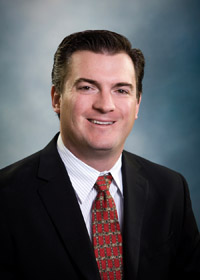Approaching the site of Santa Rosa’s Epicenter, I’m greeted by the sharp whine of saws and a flurry of controlled activity. It’s a breezy afternoon in early June, and construction of the new sports and entertainment complex is in full swing. Built within a 130,000-square-foot warehouse that was once part of the industrial facilities surrounding Santa Rosa Codding Airport, the sheer size of the place makes it difficult to take in all at once. The center is due to open in two stages; the sports side is slated to open first, in September, with the entertainment portion estimated to follow in the fall. With such a tight deadline, there’s no time left to waste.
Laying the groundwork
According to Joe Lourdeaux, vice president of development at Epicenter, the idea for the center was born out of a group of local investors in the community who wanted to do something fun, but still different. “We looked at traditional forms of family entertainment, like bowling, laser tag, and an arcade, and found the most advanced version to provide as much fun and excitement as possible. A person can come in here for an activity and experience the best the market has to offer and the hope is that they’ll explore and find something new to try each time they visit.”
Turning Epicenter from a concept on paper into a solid reality was no small undertaking. Owned by an LLC made up of a group of local investors, the project cost around $18 million in total and was financed by capital from the LLC and conventional bank debt provided by Bank of America. According to Lourdeaux, the project had been an idea in the works for years, and finding a building that was suitable for the project was the first challenge. The building first became available for lease 13 years ago, and the investors became aware of the building once the lease ran out. The building was then purchased for $10.7 million. Once the building was acquired, the permitting process took two years.
As with any audacious enterprise, there can be unforeseen obstacles along the way. According to Mark Davis, president of Wright Contracting, one of the principal difficulties came when trying to figure out how to put everything together within the confines of the space. “Epicenter is being constructed within an existing building, and there was a challenge to determine the scale, flow and layout of the different activities,” he says. “Since there’s nothing else like it around, there was nothing to compare or model from. We were taking traditional outdoor activities, bringing them indoors and blending them with other traditional indoor activities—all while getting it to scale and making sure everything flowed comfortably for guests.”
Davis is quick to point out that the design of Epicenter was a collaborative effort. “We were a participant in the process,” he says, adding, “figuring out the layout, flow and other details was a combination of ownership, AXIA Architects and Wright Contracting.”
Lourdeaux reaffirms the sentiment: “Every aspect of this building required an explanation and a conversation. It was about choosing each activity so it complimented other aspects of the project and encouraged users to experience more than just what they came for. How do you align a building with so many different activities and still make the flow feel natural?
Hit the ground running
The sports side of the building on the south side houses Sports City’s two full-size indoor soccer fields, as well as a smaller field for younger kids. There’s also Sport City’s Multi-Sports Court—a hard court for activities like basketball or volleyball and an Anytime Fitness gym, which boasts a two-storied structure. The second story looks out over the entire space—an impressive sight even in the mostly empty space I’m touring. I can only imagine how different everything will be once it’s all completed. The final area of the sports center, and my personal favorite, is the Rockin’ Jump Trampoline Park.
Each area of the sports center is imbued with thoughtful, innovative touches that add to user experience and enjoyment. Taking me on the tour, Lourdeaux points out, “In [Sports City’s] current facility they have hockey boards, which is wooden material, and then glass,” he explains. “This is OK for adults, but if you’re watching your kids play, you’re missing the action from the shoulders down. [Transparency] provides a superior viewing experience for the parents, and a cooler, more professional viewing experience for the kids.”
The fields can be equipped for sports such as flag football and lacrosse because the goals can be closed to make a solid wall. The fields and hard court will have large, see-through glass doors and windows to provide a better experience to those sitting outside on the bleachers. “From any entrance, you can see more than three activities at the same time,” says Lourdeaux. “There’s always more than one thing going on. And it’s not just sports.”
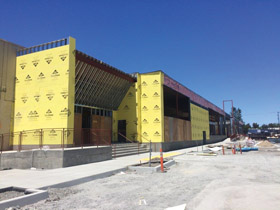 Anything you want
Anything you want
One can begin to understand what he means as we near the middle of the center, the location of the Rockin’ Jump Trampoline Park hosts five different attractions within it; a large Open Jump Arena, Dodgeball Arena, Slam Dunk Zone with two basketball hoops, Stunt Bag and an X-Beam, which features a balance beam over a foam pit. Players can hit each other with padded sticks to try to knock each other off.
Parents, rest assured, Epicenter has taken safety concerns to heart. “With the trampolines, we chose the company we did because of its safety rating,” says Lourdeaux. “That was more important to us than say, the most extreme trampoline.” The area designated for backflips and front flips, for example, offers a gigantic airbag as a landing pad.
The trampoline area will be enclosed, with one entrance and exit, making it easy to keep several kids in the area while one plays. But at Epicenter, contained doesn’t mean cut off. A person sitting at the viewing platform of the trampoline section can see everything but the Slam Dunk Zone, and you can see the Slam Dunk Zone from the Starbucks.
“When we were laying the facility out, we wanted to make sure that all the attractions complemented each other,” reflects Lourdeaux. “This placement communicates that, even though you’re coming here for Sports City, the entire building is still yours to use as well. There are sports, but there’s also entertainment. You can do anything you want here
Entertainment, upgraded
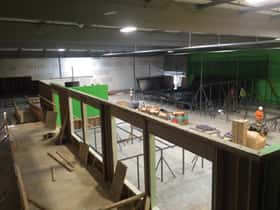 Further down from the trampolines, is the Game On Arcade. First up on the west side is Delta Strike Laser Tag. “Everything on this side of the building was actually built with adults in mind, but it’s still appropriate for children,” says Lourdeaux. “What we tried to do—and I hope what we succeeded in doing—was provide activities everyone is familiar with, but have upgraded, modern versions.” He takes me into a tall windowless room, painted floor to ceiling in black. We would have been entirely sightless, if not for a single spotlight he turns on to illuminate the space. Lourdeaux points up to the roof. “It doesn’t look like much right now, but there’s another thousand-square-foot mezzanine coming in,” he says proudly. “This will be a multi-level arena, and we’re the only one around that has that.”
Further down from the trampolines, is the Game On Arcade. First up on the west side is Delta Strike Laser Tag. “Everything on this side of the building was actually built with adults in mind, but it’s still appropriate for children,” says Lourdeaux. “What we tried to do—and I hope what we succeeded in doing—was provide activities everyone is familiar with, but have upgraded, modern versions.” He takes me into a tall windowless room, painted floor to ceiling in black. We would have been entirely sightless, if not for a single spotlight he turns on to illuminate the space. Lourdeaux points up to the roof. “It doesn’t look like much right now, but there’s another thousand-square-foot mezzanine coming in,” he says proudly. “This will be a multi-level arena, and we’re the only one around that has that.”
For the Delta Strike Laser Tag arena, Epicenter chose a company that specializes in theatrical-level theming. The company incorporates sculptures, murals, sound, lighting, smoke and lasers into the spaces it creates. The final result is “much more than just some Day-Glo paint on the wall,” says Lourdeaux. “It creates the most immersive environment and game experience possible.” The games themselves are also more advanced, with 12 different scenarios available to play. A player’s phaser can be configured with different kinds of beams for more advanced shooting capabilities. Participants shouldn’t worry about being ‘too old’ for the game, stresses Lourdeaux, as this version is “built for both adults and kids.”
The Game On Arcade, placed along on the west side, will also feature a hefty mix of active, physically engaging games, many of them as sports-based as possible, as well as popular carnival-like games from broadways and midways. As we tour, the space doesn’t have much color yet, outside of gray construction cement, but it doesn’t take much to my imagination going, picturing all the sights and sounds that will soon fill it. The video game displays are set to be top of the line; big screens that integrate aspects like 3-D and vibration to give players an experience that they can’t get at home. The goal of the arcade is to make the games as exciting and lively as possible, to erase the passivity of arcades from ages past.
The Clubhouse Suites and Grill is located directly next to the Game On Arcade, further in the middle. It features five suites that can be used for either corporate events or birthday parties. The Grill is a food and beverage option for the player who wants a quick bite to eat and to return to the Arcade floor, and is modeled after a concessions stand at a ballpark.
In the far northwest corner there’s a space designated for younger children (ages 4-12). Called a Ballistic Mega Play Structure, it’s set to cover 1200 square feet and be three levels high. The result is an area that becomes interactive instead of mundane, with no more hamster tubes.
It has a single entrance and exit to keep kids safe and contained. Inside a gigantic atrium, compressed air cannons filled with soft foam Nerf-type balls will fire back and forth across the space. Despite the highly combative sound, there’s no need for anxiety—the activity has been tried and tested by kids themselves.
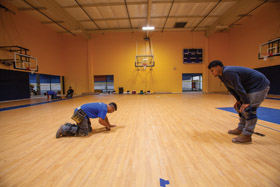 Like you’ve never seen before
Like you’ve never seen before
Everyone working at Epicenter has a space they’re most eager to see come to life, and Lourdeaux is no exception. He takes me into a small room that seems scarcely bigger than an average bedroom. It has no roof. “I’m more excited about this little room, right here, than any other part of the building,” he smiles. “This is the XD Dark Ride 7D Theater.” For those who might not know exactly what that means, combine Disneyland’s Star Tours, Midway Mania and California Soarin’ rides and you’ll have it. The room will contain eight chairs, a giant curved screen and speakers all around. The screen will have HD, 3-D projection, with chairs that move with the motion on the screen, offering a captivating experience.
There are age appropriate ride and movie options available for all groups. For younger kids, players can explore an abandoned mine in a simulated roller coaster and collect gold coins. Adults can be chased by a horde of zombies on an abandoned farm and try to escape via an old tractor. Lourdeaux’s favorite ride option is Gigamon, a Godzilla-like creature attacking an unnamed city. “I’m scared of heights, and the graphics and motion on that one were so good it scared me. I made my wife ride that one and she’s still mad at me,” he laughs.
Outside of the theater, the center opens to a large space partially concealed by high walls, giving it a more private feel. This is the section designated for Victory House, a restaurant and sports bar.
The sports bar will boast the largest restaurant-based screen in Northern California. “Anywhere someone sits, they’ll be able to see a screen,” says Lourdeaux. Victory House will feature 24 beers on tap, with Epicenter searching for as many local products for the bar as possible. “It’s an opportunity, with the wine, beer and even a lot of the food items, to showcase things that are unique to this area,” says Lourdeaux.
The Trophy Room is a banquet area near Victory House, which will have a lounge style feel, featuring couches, chairs, fireplaces, foosball tables and TVs, so players can have a place to hang out after a game and grab a bite to eat. The room is available for private parties as well, with the capacity for around 40 people.
At north end of the center, there will be 12 lanes of “boutique bowling” for those who want a more modern, upscale and social bowling environment. There will be four additional bowling lanes that have a large banquet room attached, to accommodate any corporate events or large parties. “This is really for people who bowl two or three times a year, who really want to go and have dinner and drinks and hang out with their friends,” says Lourdeaux. Instead of hard plastic chairs, the area will have couches. There will also be cool lighting to create a more relaxed ambiance.
Getting the right food was especially important for Epicenter, since the operators realize that’s a crucial aspect to get people coming back. “You have to price [the food] to where it’s approachable, affordable and family-centric,” Lourdeaux says thoughtfully. “The challenge was to find that perfect intersection between delivering quality and value. I think we’ve done a good job of that.” The ultimate hope is that Epicenter will become a place where families come to eat at the end of the day and share their experiences, much like the family dinner table at home.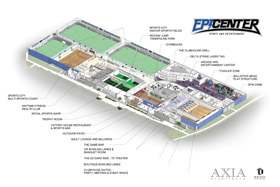 Epicenter will provide more than 250 new jobs for the community. Nearing the deadline, Lourdeaux is still full of enthusiasm and anxious to see everything come together. “If the excitement of doing something new doesn’t get you going, doesn’t motivate you, then it’s the wrong line of work to be in,” he says. “The first time I saw paint going up on the walls, I got excited. It was the realization that everything’s really happening.”
Epicenter will provide more than 250 new jobs for the community. Nearing the deadline, Lourdeaux is still full of enthusiasm and anxious to see everything come together. “If the excitement of doing something new doesn’t get you going, doesn’t motivate you, then it’s the wrong line of work to be in,” he says. “The first time I saw paint going up on the walls, I got excited. It was the realization that everything’s really happening.”
Joe Belluzzo Shoe Bank
For parents, buying new equipment for every sport season can be expensive. Thanks to the Joe Belluzo Shoe Bank at Sport City in Santa Rosa, used outdoor soccer cleats are available to players at no cost. Players can bring in their used, but good condition cleats to trade up for a new size—for free. The shoe bank runs only on donated cleats from the community, so please bring in your own used cleats to trade. Available sizes run from a youth size 10 to an adult size 8 (men’s). Shoe bank hours are by appointment only; call (707) 536-2884 to set up an appointment or fill out a simple online form. Items can be donated to the Santa Rosa facility anytime during hours of operationplaysportscity.com


